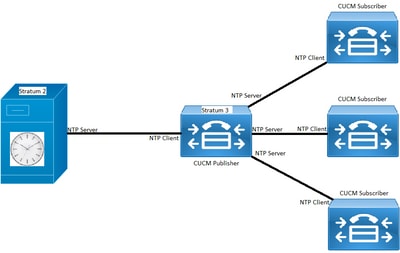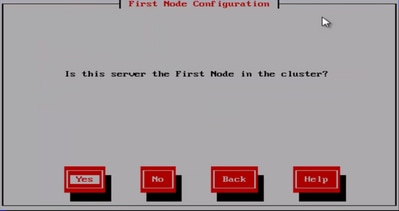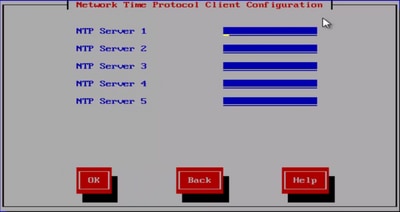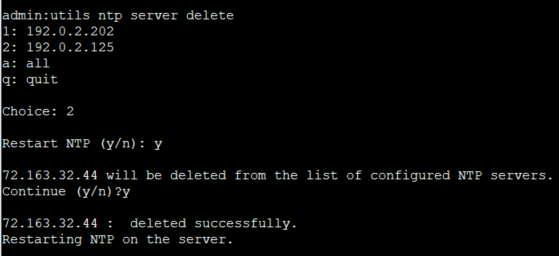Configurar e solucionar problemas do NTP no CUCM e IM&P
Opções de download
Linguagem imparcial
O conjunto de documentação deste produto faz o possível para usar uma linguagem imparcial. Para os fins deste conjunto de documentação, a imparcialidade é definida como uma linguagem que não implica em discriminação baseada em idade, deficiência, gênero, identidade racial, identidade étnica, orientação sexual, status socioeconômico e interseccionalidade. Pode haver exceções na documentação devido à linguagem codificada nas interfaces de usuário do software do produto, linguagem usada com base na documentação de RFP ou linguagem usada por um produto de terceiros referenciado. Saiba mais sobre como a Cisco está usando a linguagem inclusiva.
Sobre esta tradução
A Cisco traduziu este documento com a ajuda de tecnologias de tradução automática e humana para oferecer conteúdo de suporte aos seus usuários no seu próprio idioma, independentemente da localização. Observe que mesmo a melhor tradução automática não será tão precisa quanto as realizadas por um tradutor profissional. A Cisco Systems, Inc. não se responsabiliza pela precisão destas traduções e recomenda que o documento original em inglês (link fornecido) seja sempre consultado.
Contents
Introdução
Este documento descreve o Network Time Protocol (NTP) para o Cisco Unified Communications Manager (CUCM).
Pré-requisitos
Requisitos
Não existem requisitos específicos para este documento.
Componentes Utilizados
Este documento não se restringe a versões de software e hardware específicas.
As informações neste documento foram criadas a partir de dispositivos em um ambiente de laboratório específico. Todos os dispositivos utilizados neste documento foram iniciados com uma configuração (padrão) inicial. Se a rede estiver ativa, certifique-se de que você entenda o impacto potencial de qualquer comando.
Finalidade do recurso
Este documento aborda a finalidade do NTP com CUCM, a configuração do NTP, que dados coletar para solucionar problemas, exemplo de análise dos dados e recursos relacionados para pesquisa adicional.
A finalidade do NTP com CUCM é garantir que os servidores estejam cientes da hora correta. O tempo nos servidores CUCM é importante porque o Voice Over Internet Protocol (VOIP) é extremamente sensível a variações de tempo.
O cluster do CUCM deve manter uma sincronização de tempo que permaneça próxima aos outros servidores no cluster, devido aos requisitos de replicação de banco de dados.
Por fim, o tempo de solução de problemas é importante, pois você deseja ter os carimbos de data/hora corretos nos registros.
Configurar

Observação: o CUCM requer determinados servidores NTP.
O servidor NTP do Windows não é suportado para CUCM; no entanto, outros tipos, como fontes NTP do Linux, fontes NTP do Cisco IOS® e fontes NTP do Nexus OS, são aceitáveis.
Embora outras soluções da Cisco possam utilizar servidores Windows para a solução NTP, as soluções de UC como Call Manager, Cisco Unity e Instant Messaging and Presence não podem fazer isso e exigem uma solução NTP baseada em Linux ou Cisco IOS®.
Isso ocorre porque os Serviços de Tempo do Windows geralmente usam SNTP com o qual os sistemas Linux têm dificuldade para sincronizar.
Diagrama de Rede
O editor do CUCM precisa de uma origem NTP que não seja membro do cluster do CUCM; portanto, o editor do CUCM sincroniza seu tempo com o servidor NTP. Neste intercâmbio, o editor do CUCM é um cliente NTP.
Os assinantes do CUCM sincronizam seu tempo com o editor do CUCM. Nesta troca, o editor do CUCM é um servidor NTP onde os assinantes do CUCM são clientes NTP.
Cuidado: lembre-se de que os servidores de mensagens instantâneas e presença (IM&P) da Cisco também são considerados assinantes do cluster CUCM, portanto, eles também dependem do NTP CUCMs. Em outras palavras, se o NTP estiver fora de sincronia no servidor IM&P, ele causará problemas no sistema com sua replicação de banco de dados e alta disponibilidade.

Processo de instalação
Quando o CUCM é instalado, há um prompt para determinar se o servidor é o primeiro nó no cluster.

Se o servidor não for o primeiro nó no cluster, o assistente de instalação passará da fase de configuração do NTP; no entanto, você será solicitado a fornecer o(s) servidor(es) NTP se ele for o primeiro nó no cluster.

Após a instalação, use a página da Web OS Admin

Após a instalação, use a interface de linha de comando
Como mostrado nas imagens, você pode encontrar os comandos usados para acessar e modificar os servidores NTP no servidor CUCM.
- O comando utils ntp server list mostra os servidores NTP configurados no sistema.

- O comando utils ntp server add ntp_address adiciona um novo servidor NTP ao sistema.

Observação: lembre-se de que, se você quiser adicionar um novo servidor NTP, o servidor CUCM testa a acessibilidade antes de adicioná-lo. Se ele falhar, o próximo erro será visto.

- O comando utils ntp server delete permite excluir qualquer um dos NTPs já configurados no sistema.

Troubleshooting
Dados a Serem Coletados
Ao solucionar um problema de NTP, você é solicitado a coletar esses dados de qualquer servidor CUCM que tenha os problemas de NTP:
- A saída do comando utils diagnose test.
- A saída do comando utils ntp status.
- Os registros de NTP do CUCM coletados da ferramenta Cisco Real-Time Monitor (RTMT).
Exemplo de análise
Por exemplo, as próximas informações do Editor do CUCM e do NTP foram usadas:
Editor do CUCM
Versão: 11.5(1) SU5
FQDN: cucm-115.home.lab
O endereço IP começa com 192.X.X.X
NTP
Do servidor NTP do Google
FQDN: time1.example.com.ntp
O endereço IP começa com 216.X.X.X
Revisão PCAP para CUCM - Sem arquivo
Observe que o número da porta é 123. Esta é a porta do NTP. Na saída do comando na caixa de texto, você pode ver que a versão do NTP é 4, conforme observado pelo NTPv4. Você também pode tomar nota do editor, que atua como um cliente quando estabelece sua comunicação com time1.example.com; no entanto, ele funciona como um servidor quando estabelece a comunicação com cucm-sub1, cucm-sub2 e cucm-sub3.
From the CLI of the publisher run the command "utils network capture port 123" Wait until you see traffic (this can take a little time, or it may be instant) then hit
ctrl+c. Look in the traffic to find where your publisher is communicating with its NTP
server and the NTP server is communication with the publisher (if the NTP server isn't
replying then it is an issue in the network or with the NTP server). The primary focus of
this output is the NTP version. In CUCM 9 and later NTP version 3 (NTPv3) can cause issues
and an NTP source using NTPv4 should be the NTP server for the publisher.
admin:utils network capture size all count 10000000 port 123 Executing command with options: size=128 count=1000 interface=eth0 src=dest= port=123 ip= 16:08:43.199710 IP cucm-sub3.home.lab.39417 > cucm-115.home.lab.ntp: NTPv4, Client, length 48 16:08:43.199737 IP cucm-115.home.lab.ntp > cucm-sub3.home.lab.39417: NTPv4, Server, length 48 16:08:43.199823 IP cucm-sub3.home.lab.39417 > cucm-115.home.lab.ntp: NTPv4, Client, length 48 16:08:43.199859 IP cucm-115.home.lab.ntp > cucm-sub3.home.lab.39417: NTPv4, Server, length 48 16:09:01.640980 IP cucm-115.home.lab.50141 > time1.example.com.ntp: NTPv4, Client, length 48 16:09:01.654675 IP time1.example.com.ntp > cucm-115.home.lab.50141: NTPv4, Server, length 48 16:09:01.654733 IP cucm-115.home.lab.50141 > time1.example.com.ntp: NTPv4, Client, length 48 16:09:01.667368 IP time1.example.com.ntp > cucm-115.home.lab.50141: NTPv4, Server, length 48 16:09:01.668612 IP cucm-115.home.lab.50141 > time1.example.com.ntp: NTPv4, Client, length 48 16:09:01.681366 IP time1.example.com.ntp > cucm-115.home.lab.50141: NTPv4, Server, length 48 16:09:01.681518 IP cucm-115.home.lab.50141 > time1.google.com.ntp: NTPv4, Client, length 48 16:09:01.694108 IP time1.google.com.ntp > cucm-115.home.lab.50141: NTPv4, Server, length 48 16:09:01.875016 IP cucm-115.home.lab.48422 > time1.google.com.ntp: NTPv4, Client, length 48 16:09:01.884476 IP cucm-sub3.home.lab.58072 > cucm-115.home.lab.ntp: NTPv4, Client, length 48 16:09:01.884568 IP cucm-115.home.lab.ntp > cucm-sub3.home.lab.58072: NTPv4, Server, length 48 16:09:01.884954 IP cucm-sub3.home.lab.58072 > cucm-115.home.lab.ntp: NTPv4, Client, length 48 16:09:01.884999 IP cucm-115.home.lab.ntp > cucm-sub3.home.lab.58072: NTPv4, Server, length 48 16:09:01.885381 IP cucm-sub3.home.lab.58072 > cucm-115.home.lab.ntp: NTPv4, Client, length 48 16:09:01.885423 IP cucm-115.home.lab.ntp > cucm-sub3.home.lab.58072: NTPv4, Server, length 48 16:09:01.886147 IP cucm-sub3.home.lab.58072 > cucm-115.home.lab.ntp: NTPv4, Client, length 48 16:09:01.886184 IP cucm-115.home.lab.ntp > cucm-sub3.home.lab.58072: NTPv4, Server, length 48 16:09:01.888555 IP time1.google.com.ntp > cucm-115.home.lab.48422: NTPv4, Server, length 48 16:09:01.888642 IP cucm-115.home.lab.48422 > time1.google.com.ntp: NTPv4, Client, length 48 16:09:01.900926 IP time1.google.com.ntp > cucm-115.home.lab.48422: NTPv4, Server, length 48 16:09:01.901017 IP cucm-115.home.lab.48422 > time1.google.com.ntp: NTPv4, Client, length 48 16:09:01.913497 IP time1.google.com.ntp > cucm-115.home.lab.48422: NTPv4, Server, length 48 16:09:01.913566 IP cucm-115.home.lab.48422 > time1.google.com.ntp: NTPv4, Client, length 48 16:09:01.926693 IP time1.google.com.ntp > cucm-115.home.lab.48422: NTPv4, Server, length 48 16:09:02.038981 IP cucm-sub2.home.lab.42078 > cucm-115.home.lab.ntp: NTPv4, Client, length 48 16:09:02.039117 IP cucm-115.home.lab.ntp > cucm-sub2.home.lab.42078: NTPv4, Server, length 48 16:09:02.039281 IP cucm-sub2.home.lab.42078 > cucm-115.home.lab.ntp: NTPv4, Client, length 48 16:09:02.039345 IP cucm-115.home.lab.ntp > cucm-sub2.home.lab.42078: NTPv4, Server, length 48 16:09:02.039434 IP cucm-sub2.home.lab.42078 > cucm-115.home.lab.ntp: NTPv4, Client, length 48 16:09:02.039535 IP cucm-115.home.lab.ntp > cucm-sub2.home.lab.42078: NTPv4, Server, length 48 16:09:02.039607 IP cucm-sub2.home.lab.42078 > cucm-115.home.lab.ntp: NTPv4, Client, length 48 16:09:02.039814 IP cucm-115.home.lab.ntp > cucm-sub2.home.lab.42078: NTPv4, Server, length 48 16:09:02.066544 IP cucm-sub1.home.lab.46400 > cucm-115.home.lab.ntp: NTPv4, Client, length 48 16:09:02.066622 IP cucm-115.home.lab.ntp > cucm-sub1.home.lab.46400: NTPv4, Server, length 48 16:09:02.066751 IP cucm-sub1.home.lab.46400 > cucm-115.home.lab.ntp: NTPv4, Client, length 48 16:09:02.066892 IP cucm-115.home.lab.ntp > cucm-sub1.home.lab.46400: NTPv4, Server, length 48 16:09:02.066968 IP cucm-sub1.home.lab.46400 > cucm-115.home.lab.ntp: NTPv4, Client, length 48 16:09:02.067104 IP cucm-115.home.lab.ntp > cucm-sub1.home.lab.46400: NTPv4, Server, length 48 16:09:02.067155 IP cucm-sub1.home.lab.46400 > cucm-115.home.lab.ntp: NTPv4, Client, length 48 16:09:02.067189 IP cucm-115.home.lab.ntp > cucm-sub1.home.lab.46400: NTPv4, Server, length 48
Revisão PCAP para CUCM - Com arquivo
O filtro usado para solucionar problemas de NTP na captura de pacotes é: udp.port == 123. Com esse filtro, você pode ver que o editor do CUCM estabeleceu comunicação com o servidor NTP do Google e que o editor do CUCM se comunicou com os assinantes do CUCM também.

Revisão da saída CLI para CUCM
saída de status NTP de utils
NOTE: All nodes will show the current time in UTC regardless of the time zone of the server
(listed in UTC time). This makes it easy to compare times on the different CUCM nodes.
NOTE: If there is a time difference of 15 minutes or more, it is expected that DB replication
will be broken
1) If the publisher is ahead by 15 minutes, this can result in the pub send data to the
sub and the sub would have a delay to process the data because it has not yet reached the time
in the timestamp of the packets from the publisher (this is expected behavior in this type of situation)
2) If the subscriber is ahead by 15 minutes, this would result in the subscriber drop
the data from the publisher because the subscriber sees it as old data (15 minutes old)
admin:utils ntp status
ntpd (pid 28435) is running...
remote refid st t when poll reach delay offset jitter
==============================================================================
203.0.113.0 .GOOG. 1 u 44 64 3 11.724 -0.021 0.064
unsynchronised
polling server every 8 s
Current time in UTC is : Fri Sep 6 20:54:50 UTC 2019
Current time in America/New_York is : Fri Sep 6 16:54:50 EDT 2019
admin:
Leia as informações a seguir, pois elas explicam a saída anterior em detalhes.
The very first column contains the "tally code" character. Short overview:
* the source you are synchronized to (syspeer)
# source selected, distance exceeds maximum value
o the PPS(Pulse Per Second) source if your ntpd (ppspeer, only if you have a PPS capable system and refclock)
+ candidate, i.e. it is considered a good source
- outlyer, i.e. quality is not good enough
x falseticker, i.e. this one is considered to distribute bad time
blank: source discarded, failed sanity
See the Select field of the Peer status word on the NTP Event Messages and
Status Words page for more information on the tally codes.
remote
the hostname or IP of the remote machine.
refid
the identification of the time source to which the remote machines is synced.
May be (for example) a radio clock or another ntp server)
st
the stratum of the remote machine. 16 is "unsynchronized". 0 is the best
value, that could be (for example) a radio clock or the ntp servers private
caesium clock (see http://www.eecis.udel.edu/~mills/ntp/html/index.html#intro
for more information about ntp in general).
t
types available:
l = local (such as a GPS, WWVB)
u = unicast (most common)
m = multicast
b = broadcast
- = netaddr
when
how many seconds since the last poll of the remote machine.
poll
the polling interval in seconds.
reach
an 8-bit left-rotating register. Any 1 bit means that a "time packet" was
received. The right most bit indicate the status of the last connection
with the NTP server. It is Octal number. Use calculator in progammer
interface to translate from OCT to BIN: For example 377 translates to
11111111. Each 1 means a successful connection to the NTP server. If you
just start a NTP service, and it connects successfully with its server, this
number will change as follows (if connectivity is good):
00000001 = 001
00000011 = 003
00000111 = 007
00001111 = 017
00011111 = 037
00111111 = 077
01111111 = 177
11111111 = 377
delay
the time delay (in milliseconds) to communicate with the remote.
offset
the offset (in milliseconds) between our time and that of the remote.
jitter
the observed jitter (in milliseconds) of time with the remote.
Utiliza o diagnóstico de saída de teste
admin:utils diagnose test Log file: platform/log/diag1.log Starting diagnostic test(s) =========================== test - disk_space : Passed (available: 6463 MB, used: 12681 MB) skip - disk_files : This module must be run directly and off hours test - service_manager : Passed test - tomcat : Passed test - tomcat_deadlocks : Passed test - tomcat_keystore : Passed test - tomcat_connectors : Passed test - tomcat_threads : Passed test - tomcat_memory : Passed test - tomcat_sessions : Passed skip - tomcat_heapdump : This module must be run directly and off hours test - validate_network : Passed test - raid : Passed test - system_info : Passed (Collected system information in diagnostic log) test - ntp_reachability : Passed test - ntp_clock_drift : Passed test - ntp_stratum : Passed skip - sdl_fragmentation : This module must be run directly and off hours skip - sdi_fragmentation : This module must be run directly and off hours Diagnostics Completed The final output will be in Log file: platform/log/diag1.log Please use 'file view activelog platform/log/diag1.log' command to see the output admin:
Se o NTP falhar na saída do teste de diagnóstico de utils, você verá algo semelhante a isto:
admin:utils diagnose test Log file: platform/log/diag1.log Starting diagnostic test(s) =========================== test - disk_space : Passed (available: 6463 MB, used: 12681 MB) skip - disk_files : This module must be run directly and off hours test - service_manager : Passed test - tomcat : Passed test - tomcat_deadlocks : Passed test - tomcat_keystore : Passed test - tomcat_connectors : Passed test - tomcat_threads : Passed test - tomcat_memory : Passed test - tomcat_sessions : Passed skip - tomcat_heapdump : This module must be run directly and off hours test - validate_network : Passed test - raid : Passed test - system_info : Passed (Collected system information in diagnostic log) test - ntp_reachability : Warning The NTP service is restarting, it can take about 5 minutes. test - ntp_clock_drift : Warning The local clock is not synchronised. None of the designated NTP servers are reachable/functioning or legitimate. test - ntp_stratum : Warning The local clock is not synchronised. None of the designated NTP servers are reachable/functioning or legitimate. skip - sdl_fragmentation : This module must be run directly and off hours
Confirme se o NTP estava bom no momento da instalação. Execute o comando:
execute sql select pkid,name,dbinfo('utc_to_datetime', cdrtime) as CDRTIME do dispositivo onde cdrtime > getCurrTime()
Esse comando compara a hora atual com a hora do cdrtime (quando a tabela foi modificada). Se você usou um NTP inválido na instalação/atualização e corrigiu o NTP, o banco de dados perderá a sincronização toda vez que uma alteração for feita. Esse problema não seria visto quando você executa os comandos NTP típicos (por exemplo, utils ntp status) porque você mudou da origem NTP incorreta para uma boa.
Seria bom que você saísse do NTP incorreto para um bom; no entanto, um movimento para uma boa origem de NTP não corrigiria as tabelas que foram criadas durante a instalação/atualização.
Quando você executa esse comando, a saída esperada é:
admin:run sql select pkid,name,dbinfo('utc_to_datetime', cdrtime) as CDRTIME from device where cdrtime > getCurrTime()
pkid name cdrtime
==== ==== =======
admin:
Se você tiver uma saída semelhante à seguinte, isso é um sinal de que o NTP usado para a instalação/atualização não foi usado e causou problemas que afetam a replicação do banco de dados:
admin:run sql select pkid,name,dbinfo('utc_to_datetime', cdrtime) as CDRTIME from device where cdrtime > getCurrTime()
pkid name cdrtime
============================= ===== =====================
bf80dd31-9911-43ce-81fd-a99ec0333fb5 MTP_2 2016-09-11 14:38:14.0
4c38fc05-760d-4afb-96e8-69333c195e74 CFB_2 2016-09-11 14:38:14.0
90878c80-e213-4c7e-82b9-6c780aac72f3 ANN_2 2016-09-11 14:38:14.0
08b5bff4-da94-4dfb-88af-ea9ffa96872c MOH_2 2016-09-11 14:38:14.0
93320e4d-1b73-4099-9a7c-c4cddfadb5d9 MTP_3 2016-09-11 14:38:14.0
a6850d42-5f0a-49ce-9fa3-80d45b800e23 CFB_3 2016-09-11 14:38:14.0
9963c9cb-58b0-4191-93e1-8676584f6461 ANN_3 2016-09-11 14:38:14.0
def79fb7-c801-4fb3-85fb-4e94310bf0bd MOH_3 2016-09-11 14:38:14.0
4cd64584-089b-4331-9291-79774330cbc 2 MTP_4 2016-09-11 14:38:14.0
27b18882-db83-4d14-8bce-d3f8dc439610 CFB_4 2016-09-11 14:38:14.0
a40da882-e04f-4649-b2eb-2f79d1289e81 ANN_4 2016-09-11 14:38:14.0
36575ff4-cdea-4945-87e7-638cc555463e MOH_4 2016-09-11 14:38:14.0
Outras considerações
1) Se você atualizar os hosts ESXi sem considerar as considerações de hardware da VM, poderá ter problemas de NTP.
2) Certifique-se de que a versão do ESXi esteja em conformidade com a matriz de virtualização.
3) Verifique se a versão do ESXi e a versão do hardware são compatíveis.
Informações Relacionadas
- Suporte Técnico e Documentação - Cisco Systems
- Designs de rede de referência da solução Cisco Collaboration System 10.x (SRND)
- Alterar a fonte de NTP no CUCM a partir da CLI e de outras informações úteis
- Solução de problemas de NTP no Cisco Unified Communications Manager
- Network Time Protocol: White paper sobre práticas recomendadas
- Captura de pacotes no modelo do dispositivo CUCM
Histórico de revisões
| Revisão | Data de publicação | Comentários |
|---|---|---|
4.0 |
22-Nov-2023 |
Introdução, texto alternativo e formatação atualizados para atender às diretrizes atuais da Cisco. |
3.0 |
18-Oct-2022 |
PII potencial atualizado e otimização do mecanismo de pesquisa. |
2.0 |
15-Mar-2022 |
Atualizações gramaticais. |
1.0 |
20-May-2020 |
Versão inicial |
Colaborado por engenheiros da Cisco
- Patrick KinaneEngenheiro do Cisco TAC
Contate a Cisco
- Abrir um caso de suporte

- (É necessário um Contrato de Serviço da Cisco)
 Feedback
Feedback